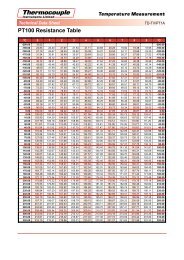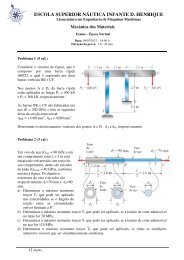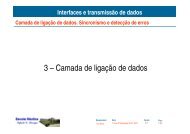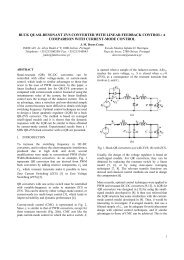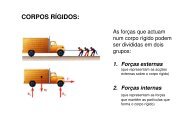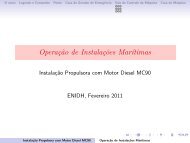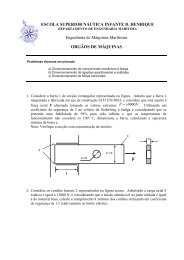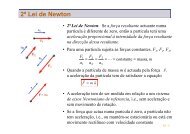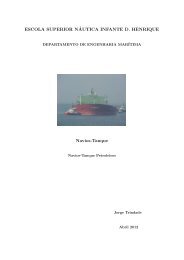Textos de Apoio (pdf)
Textos de Apoio (pdf)
Textos de Apoio (pdf)
You also want an ePaper? Increase the reach of your titles
YUMPU automatically turns print PDFs into web optimized ePapers that Google loves.
Chapter 2<br />
Propeller Propulsion<br />
The traditional agent employed to<br />
move a ship is a propeller, sometimes<br />
two and, in very rare cases, more than<br />
two. The necessary propeller thrust T<br />
required to move the ship at speed V<br />
is normally greater than the pertaining<br />
towing resistance R T<br />
, and the flow-related<br />
reasons are, amongst other reasons,<br />
explained in this chapter. See also Fig. 6,<br />
where all relevant velocity, force, power<br />
and efficiency parameters are shown.<br />
Propeller types<br />
Propellers may be divi<strong>de</strong>d into the following<br />
two main groups, see also Fig. 7:<br />
Velocities<br />
Ship’s speed<br />
: V<br />
Arriving water velocity to propeller : VA<br />
(Speed of advance of propeller)<br />
Effective wake velocity<br />
: V = V _ W<br />
VA<br />
V _ V<br />
Wake fraction coefficient : w =<br />
V<br />
Forces<br />
Towing resistance<br />
: RT<br />
Thrust force<br />
: T<br />
Thrust <strong>de</strong>duction fraction : F = T _ RT<br />
Thrust <strong>de</strong>duction coefficient : t = T _ RT<br />
T<br />
V A<br />
V<br />
A<br />
Power<br />
Effective (Towing) power : P<br />
E<br />
= RT<br />
x V<br />
Thrust power <strong>de</strong>livered<br />
by the propeller to water : P<br />
T<br />
= P<br />
E<br />
/<br />
Power <strong>de</strong>livered to propeller : P<br />
D<br />
= P<br />
T<br />
/<br />
Brake power of main engine : P = P /<br />
Efficiencies<br />
1<br />
_<br />
t<br />
Hull efficiency : H =<br />
1<br />
_<br />
w<br />
Relative rotative efficiency : R<br />
Propeller efficiency - open water : 0<br />
Propeller efficiency - behind hull : B = 0 x R<br />
Propulsive efficiency : D = H x B<br />
Shaft efficiency : S<br />
Total efficiency : T<br />
T<br />
P P P P<br />
= = = =<br />
P P P P<br />
E E T D<br />
---- ---- x ---- x ---- H x B x S H x 0 x R x S<br />
B T D B<br />
B<br />
D<br />
H<br />
B<br />
S<br />
V W<br />
P D<br />
P E<br />
• Fixed pitch propeller (FP-propeller)<br />
• Controllable pitch propeller<br />
(CP-propeller)<br />
Propellers of the FP-type are cast in<br />
one block and normally ma<strong>de</strong> of a copper<br />
alloy. The position of the bla<strong>de</strong>s, and<br />
thereby the propeller pitch, is once and<br />
for all fixed, with a given pitch that cannot<br />
be changed in operation. This<br />
means that when operating in, for example,<br />
heavy weather conditions, the<br />
propeller performance curves, i.e. the<br />
combination of power and speed<br />
(r/min) points, will change according to<br />
the physical laws, and the actual propeller<br />
curve cannot be changed by the<br />
crew. Most ships which do not need a<br />
particularly good manoeuvrability are<br />
equipped with an FP-propeller.<br />
F<br />
T<br />
P T P B<br />
V<br />
Fig. 6: The propulsion of a ship – theory<br />
Fixed pitch propeller (FP-Propeller) Controllable pitch propeller (CP-Propeller)<br />
R T<br />
Propellers of the CP-type have a relatively<br />
larger hub compared with the<br />
FP-propellers because the hub has to<br />
have space for a hydraulically activated<br />
mechanism for control of the pitch (angle)<br />
of the bla<strong>de</strong>s. The CP-propeller is<br />
relatively expensive, maybe up to 3-4<br />
times as expensive as a corresponding<br />
FP-propeller. Furthermore, because of<br />
the relatively larger hub, the propeller<br />
efficiency is slightly lower.<br />
CP-propellers are mostly used for<br />
Ro-Ro ships, shuttle tankers and similar<br />
ships that require a high <strong>de</strong>gree of<br />
Monobloc with fixed<br />
propeller bla<strong>de</strong>s<br />
(copper alloy)<br />
Fig. 7: Propeller types<br />
Hub with a mechanism<br />
for control of the pitch<br />
of the bla<strong>de</strong>s<br />
(hydraulically activated)<br />
10


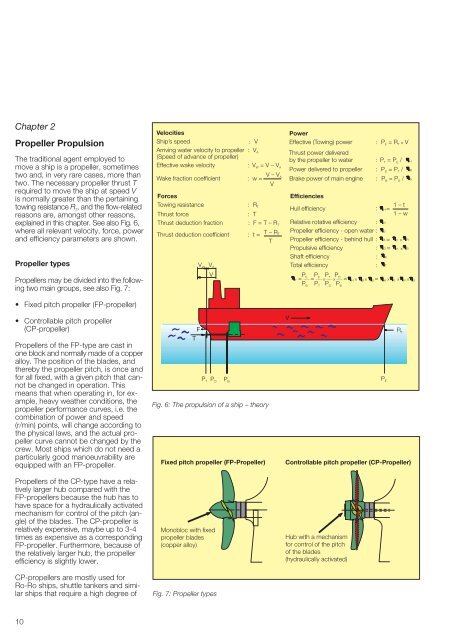
![Conceitos transmissao de dados .Sinais[.pdf]](https://img.yumpu.com/50982145/1/190x146/conceitos-transmissao-de-dados-sinaispdf.jpg?quality=85)
![Packages e interfaces[.pdf]](https://img.yumpu.com/50629553/1/190x134/packages-e-interfacespdf.jpg?quality=85)
